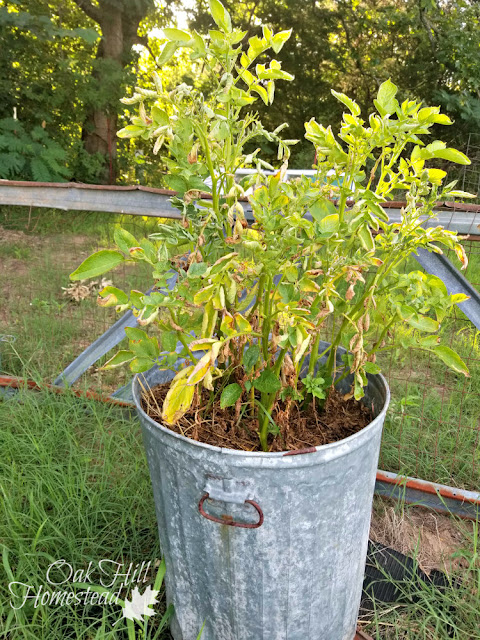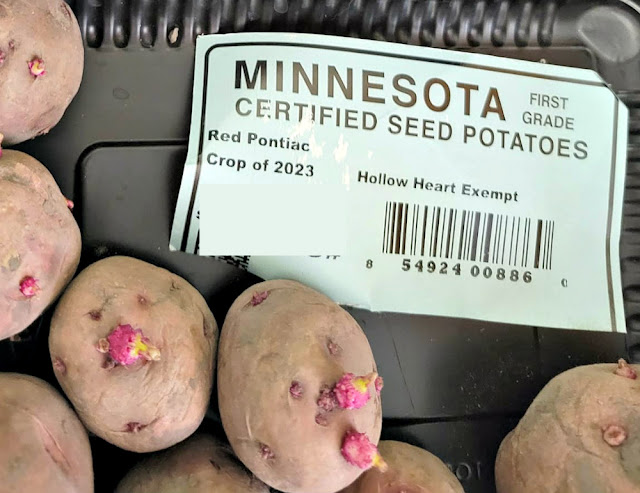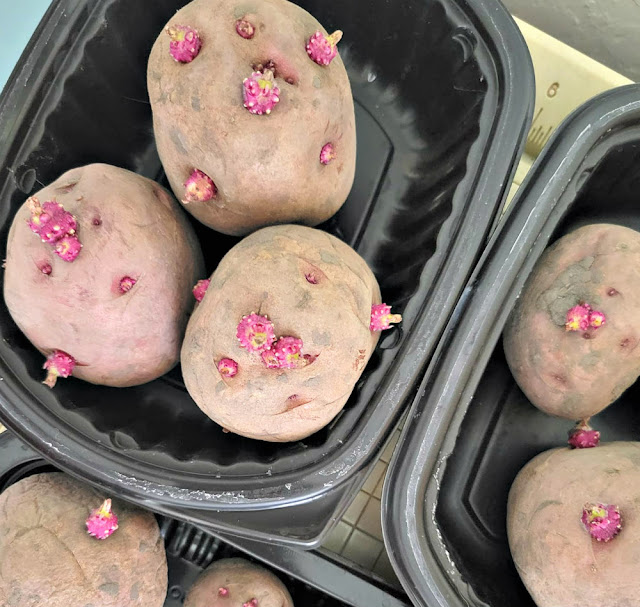Discover how to plant potatoes in containers, even if you have limited or no backyard space. Potatoes thrive in containers, making them perfect for small-space gardens.
Whether you choose grow bags, buckets, or another alternative, containers provide an excellent environment for growing your own potatoes.
Want to listen instead?
How to plant potatoes in containers
Potatoes aren’t difficult to grow, but there are a few things you need to pay attention to.
I admit that my first attempt at growing potatoes many years ago resulted in a rotted mess and no harvest. I’d planted them in the ground, in our heavy clay soil.
Potatoes like well-drained soil and if they are too wet, well, they rot.
My second attempt seemed to be doing pretty well until an armadillo dug up the spuds in the middle of the night.
Then I remembered the metal trash can in the yard that I’d used as a tomato planter one year.
My husband had drilled holes on the outside near the bottom of the can all those years ago for me, so water would drain out and the potatoes wouldn’t be sitting in the mud.
I did ask him to drill a few more drainage holes though. Everything I read about growing potatoes says they like VERY well-drained soil.
I even put several bricks under the edge of the trash can so it was above the ground and the water could drain freely.
And it worked! I had a pretty good crop of Yukon Golds. That trash can was armadillo-proof!
Growing potatoes in containers
Trash cans aren’t the only thing you can grow potatoes in. You can grow them in 5-gallon buckets too. Any container that is large enough so the plant can produce tubers under the soil should work.
I've used cat litter buckets in the past too, with one plant in each bucket.
Another benefit of using containers to grow potatoes is that you can provide good soil. That heavy clay that I first tried to grow potatoes in is NOT what potatoes like. They need light and fluffy soil that will drain well, and that the tubers can grow in.
Let’s look at it this way… if your soil turns into a hard brick after it rains and then dries out like a hard brick or rock, there’s no room for the potatoes to grow. A potato can’t grow inside a brick, there’s simply no space.
If your soil is poor - if it’s heavy clay like mine was - you can add lots of organic material to it such as aged compost or fallen leaves.
It’s amazing what this will do to your soil! Compost adds nutrients, changes the texture of the soil, and enables water to drain out of heavy clay soil while it helps sandy soil hold in the moisture. Pretty amazing, right?
If you’re buying soil for your potato containers, a mixture of potting soil and compost works well for potatoes. You can add a bit of sand if you think the soil still looks too heavy. You want a rich, loamy mixture of soil.
Containers for potatoes
Your containers need lots of drainage holes. Trust me, one hole in the middle of the bottom isn’t enough. Drill several on the bottom and drill more around the outside of the container near the bottom.
You can grow 1, or maybe 2, potato plants in a five-gallon bucket or grow bag, and more in a trash can. This year, as well as my trash can, I’m trying ten-gallon grow bags.
If you have a pile of empty feed sacks or even dog food bags (not the paper kind, the ones made of that plastic fabric), you can try growing potatoes in feed sacks. Poke lots of holes in the bottom of the sack with a screwdriver, and roll the top of the bag down a couple of times to give it more strength and structure.
Best potatoes to grow
Then you’ll need your potatoes, of course.
Potatoes aren't grown from actual seeds, but from "seed potatoes." These potatoes from the year before are planted this year. The new plants grow from the eyes in the potatoes.
While my first attempts were planted with potatoes from the grocery store, I use certified seed potatoes now. Potatoes are very prone to bacterial and fungal diseases. There is a long list of diseases that affect potatoes.
Grocery store potatoes might be carrying those diseases, like blight and fusarium. They could introduce these pathogens into your garden soil.
In fact, potato blight is the probable cause of the Irish potato famine in the 1840’s. The crops failed due to the disease, causing the death of tens of thousands of people across Europe.
Since potatoes and tomatoes are both in the nightshade family, they are both susceptible to the same diseases, including blight. So introducing blight into your soil with diseased potatoes can affect your garden for years to come, and more than just your tomato plants.
Growing grocery store potatoes in containers can help prevent the spread of these diseases, but the soil in your containers shouldn’t be added to your garden beds or compost pile after you’ve grown and harvested grocery store potatoes, just in case.
Your other choice is to buy seed potatoes at the garden center, feed store, or farm store. These potatoes are certified disease free.
Small potato varieties grow best in containers.
Determinate and indeterminate potatoes
Also, I recommend planting determinate potato varieties.
Wait - there are determinate and indeterminate potatoes? Isn't that a tomato thing?
Nope, potatoes also come in determinate and indeterminate varieties. Just like tomatoes, the determinate type produce all their tubers at once, and the indeterminate types produce their crop continuously over a longer period of time.
Seed potato companies don’t seem to label them as determinate and indeterminate though, which makes things rather difficult.
If you grow early or mid-season potatoes, they are probably determinate. Indeterminate types are usually labeled as late season.
Fingerling, red pontiac, superior and yukon gold potato varieties are early to mid season, determinate varieties.
Another benefit of growing early to mid season (determinate) potatoes is that they are less likely to fall victim to blight.
Believe me, knowing the difference is a game changer. Determinate types grow differently than indeterminate types.
How potatoes grow
Indeterminate potatoes grow their tubers all along the stem of the plant, from the seed potato at the bottom right up to the top of the soil. Indeterminate potatoes are well-suited to growing in tall containers, such as trash cans, that give them lots of room to grow their tubers.
Determinate potatoes grow their tubers in one level, just above the seed potato.
Determinate potatoes are great if you have a short growing season, since they ripen earlier than indeterminate types.
They’re also great if you live in a hot climate like I do. They are ready to harvest before the weather gets too hot, causing the roots to overheat.
How to chit potatoes
"Chitting" is how you prepare seed potatoes for planting.
About 2-4 weeks before your last expected freeze, you should chit the potatoes.
This means bringing the potatoes out of storage, and setting them in a single layer in trays with the narrow end down, so the potatoes will begin to sprout.
A popular container for chitting potatoes is an egg carton, with one potato sitting in each cavity. A tray or baking pan can be used too.
A platter will also work if that's all you have, but it's harder to get the potatoes to stand up on the narrow end of something without "sides" to prop them up against.
Put the trays in a single layer in a warm, well-lit room. After a week or so sprouts will begin growing from the “eyes” of the potatoes.
Your sprouts should be green or even purplish - not white or pale green, which happens when the potatoes aren’t getting enough light. The sprouts should be short and compact, instead of long and leggy as though they are reaching for the light.
When the sprouts are about an inch tall you can cut the potatoes into pieces, each with 2-3 eyes or sprouts. Small potatoes can be planted whole.
After cutting, let the potatoes sit for a couple of days before planting, so the cut sides can heal over.
When to plant potatoes
You can plant potatoes outside in containers a week or two before your last average frost date. Potato vines are susceptible to frost, but we are going to cover the sprouts with soil that will protect them from frost.
How to plant potatoes in a container
Now to plant your potatoes. Wait at least two days after you’ve cut your potatoes into pieces, with at least two eyes or sprouts per piece.
Make sure the drainage holes in your container are open and not clogged with dirt or debris. Remember, potatoes like well-draining soil. Too much moisture can cause them to rot or to develop fungal issues.
Move your containers to a sunny spot before you fill them. Dirt is heavy! Potatoes like 6-8 hours of sunlight.
Put about 4 inches of soil in your container. You can add some bone meal and blood meal to this soil and mix it well. Potatoes are heavy feeders so this will help give them the boost they’ll need. Use twice as much bone meal as blood meal.
Set a few potato pieces or small potatoes on top of the soil, with the sprouts facing up. Cover the pieces with another three inches or so of your soil mix.
Now wait for your potatoes to begin growing. When the leaves break through the top of the soil, you can plant another layer of potato pieces, and then fill your container with soil, leaving the top inch or two of the container empty.
How to plant potatoes in a bucket
If you’re using a five-gallon bucket as your container, plant just one potato piece on the bottom layer and perhaps one more as a second layer. Any more than that, and your potatoes won’t have enough room for the tubers to grow.
Fill the last 2 inches of the container with straw or dry leaves. This mulch will help keep the roots cool, conserve moisture and keep the potatoes from being exposed to sunlight, which would turn them green.
If your container is large enough and deep enough - like my trash can - you can add a third layer too. Like before, add about three inches of soil on top of the second layer, then wait till the leaves of the first and second layers are showing above the soil level, and add the third layer of potato pieces and fill the rest of the container.
Whether you plant 2 layers or 3, you should offset the potato pieces. In other words, if you put the first layer of pieces in a triangle, with one piece at each corner of the triangle, the second layer should also be a triangle with the potato pieces in between the first layer’s pieces.
How far apart do you plant potatoes in a container?
This brings up an interesting question: how far apart to plant potatoes when they’re growing in containers?
Common practice is to plant them 10 inches apart. This can be difficult to measure though if you’re using containers, and also if you’re planting in layers.
You’d need a large container - like that trash can - to plant four potatoes in one layer.
How deep do you plant potatoes?
Plant them near the bottom of the container. Determinate potatoes grow their tubers in one layer above the sprouted potato piece, so you want enough room above that for the potatoes to grow.
By planting two layers of potato pieces, you can grow tubers in two layers. They’ll have more space to grow potatoes than if you plant two pieces at the same depth.
Do you plant potatoes with the sprout up or down?
Potatoes should be planted with the eyes or sprouts facing up.
Caring for potato plants
Potatoes like 1-2” of water weekly, but they don’t like to be waterlogged. Water consistently instead of once a week. Underwatering will give you smaller potatoes, but overwatering will cause them to rot.
Add more compost on top of the container about midway through the season, to feed the plants.
Check your plants weekly, looking for pests, like the orange and black striped Colorado potato beetle, and signs of disease.
When the plants flower and the leaves begin to turn yellow and die back, it’s time to harvest your potatoes, which is easy to do when you grow them in containers.
Just turn the container over and dump it out, then pick up the potatoes.
The secrets of growing potatoes in containers
Let’s recap the secrets of growing potatoes in containers:
- Potatoes need well-draining soil.
- Choose between determinate and indeterminate types (early season or late season)
- Buy certified seed potatoes to lessen the chance of diseases in your soil
- Chit your potatoes for a week or two so they’ll sprout
- Cut the sprouted potatoes in pieces with at least 3 eyes or sprouts, and let them heal for several days before planting. Leave small potatoes whole.
- Plant potatoes in containers 1-2 weeks before the last average frost date
- Plant the sprouted potato pieces near the bottom of the container with the sprouts facing upwards
- Water potatoes consistently but don’t let the container become waterlogged.
- Add more compost halfway through the season to fertilize the plants
- Check your plants weekly, looking for pests and any signs of disease.
- When the plants flower and the leaves turn yellow and die back, it’s time to harvest. Just dump the container over and pick up your potatoes!
~~~~~
My mission is to inspire and encourage you to live a simple, joyful life,
no matter your circumstances or where you live. Join me here:
Facebook | Pinterest | Instagram | Subscribe




















